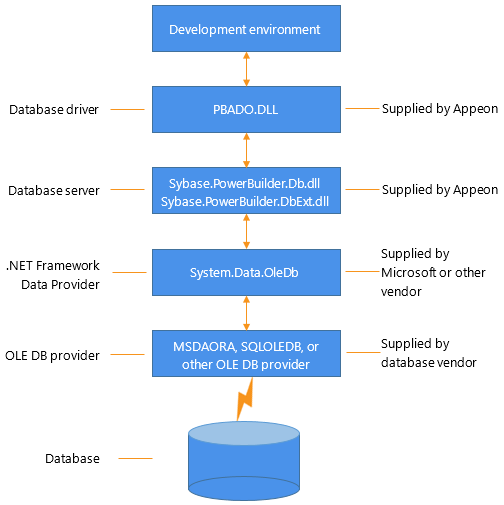You can use the InfoMaker ADO.NET database interface to connect to a data source such as Adaptive Server Enterprise, Oracle, and Microsoft SQL Server, as well as to data sources exposed through OLE DB and XML, in much the same way as you use the InfoMaker ODBC and OLE DB database interfaces.
Performance
You might experience better performance if you use a native database interface. The primary purpose of the ADO.NET interface is to support shared connections with other database constructs such as the .NET DataGrid in Appeon DataWindow .NET.
When you access a database using ADO.NET in InfoMaker, your connection goes through several layers before reaching the database. It is important to understand that each layer represents a separate component of the connection, and that components might come from different vendors.
The InfoMaker ADO.NET interface consists of a driver (pbado.dll) and a server (pbdata.dll). Both DLLs must be deployed with an application that connects to a database using ADO.NET.
In this release, the InfoMaker database interface for ADO.NET supports the .NET namespace System.Data.OleDb, which is the .NET Framework data provider for OLE DB.
Additional .NET Framework data providers will be supported in future releases. Please see the release bulletin for the latest information.
The following figure shows the general components of an ADO.NET connection using the OLE DB .NET Framework data provider.
Figure: Components of an ADO.NET OLE DB connection

When you use the .NET Framework data provider for OLE DB, you connect to a database through an OLE DB data provider, such as Microsoft's SQLOLEDB or MSDAORA or a data provider from another vendor.
The .NET Framework Data Provider for OLE DB does not work with the MSDASQL provider for ODBC, and it does not support OLE DB version 2.5 interfaces.
You can use any OLE DB data provider that supports the OLE DB interfaces listed in the following table with the OLE DB .NET Framework data provider. For more information about supported providers, see the topic on .NET Framework data providers in the Microsoft .NET Framework Developer's Guide.
|
OLE DB object |
Required interfaces |
|---|---|
|
OLE DB Services |
IDataInitialize |
|
DataSource |
IDBInitialize IDBCreateSession IDBProperties IPersist |
|
Session |
ISessionProperties IOpenRowset |
|
Command |
ICommandText ICommandProperties |
|
MultipleResults |
IMultipleResults |
|
RowSet |
IRowset IAccessor IColumnsInfo IRowsetInfo (only required if DBTYPE_HCHAPTER is supported) |
|
Error |
IErrorInfo IErrorRecords |
After you install the data provider, you might need to define a data source for it. To define a data source for one of the OLE DB data providers shipped with InfoMaker, use the DataDirect OLE DB Administrator. This utility is named PBadmin and can be found in SAP\Shared\DataDirect.


